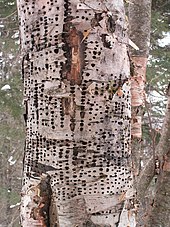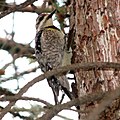Yellow-bellied sapsucker
| Yellow-bellied sapsucker | |
|---|---|

| |
| Male | |

| |
| Female, Cuba | |
| Scientific classification | |
| Kingdom: | |
| Phylum: | |
| Class: | |
| Order: | |
| Family: | |
| Genus: | |
| Species: | S. varius
|
| Binomial name | |
| Sphyrapicus varius (Linnaeus, 1766)
| |
The yellow-bellied sapsucker (Sphyrapicus varius) is a medium-sized woodpecker that breeds in Canada and the north-northeastern United States.
Taxonomy
The yellow-bellied sapsucker is one of four species in the genus Sphyrapicus.[2] First described by Carl Linnaeus in 1766, it is monotypic across its sizable range.[3] The genus name Sphyrapicus is a combination of the Greek words sphura, meaning "hammer" and pikos, meaning "woodpecker". The specific varius is Latin for "diverse".[4]
Description
The yellow-bellied sapsucker is a mid-sized woodpecker, measuring 18–22 cm (7.1–8.7 in) in length, 34–40 cm (13–16 in) in wingspan and weighing from 40–63 g (1.4–2.2 oz).[5][6] Adults are black on the back and wings with white bars; they have a black head with white lines down the side and a red forehead and crown, a yellow breast and upper belly, a white lower belly and rump and a black tail with a white central bar. Adult males have a red throat; females have a white throat.
Vocalization
They drum and give a cat-like call in spring to declare ownership of territory.
Similar species
The red-naped sapsucker is distinguished by having a red nape (back of the head). The hairy woodpecker has no red on the crown (front of the head) or throat and has blacker back. The downy woodpecker has same markings as the hairy woodpecker but is significantly smaller.
Distribution and habitat
The breeding habitat of the yellow-bellied sapsucker is forested areas across Canada, eastern Alaska and the northeastern United States. They prefer young, mainly deciduous forests. There is also a disjunct population found in high elevations of the Appalachian Mountains in Virginia, Tennessee, and North Carolina.
Ecology and behavior

Diet
Like other sapsuckers, these birds drill holes in trees and eat the sap and insects drawn to it. They may also pick insects from tree trunks or catch them in flight. They also eat fruit and berries.
Reproduction
Yellow-bellied sapsuckers nest in a large cavity excavated in a deciduous tree, often choosing one weakened by disease; the same site may be used for several years. Both the male and the female work in making the nest, where five or seven white eggs are well concealed. Both birds share in hatching.[7]
They will mate with the same partner from year to year, as long as both birds survive. They sometimes hybridize with red-naped sapsuckers or red-breasted sapsuckers where their breeding ranges overlap.
Wintering and migration
These birds migrate to the southeastern United States, West Indies and Central America, leaving their summer range. This species has occurred as a very rare vagrant to Ireland and Great Britain.
Conservation
In the United States, yellow-bellied sapsuckers are listed and protected under the Migratory Bird Treaty Act.[8] Taking, killing, or possessing this species is illegal without a permit.
Relationship with humans
Damage to trees
Because yellow-bellied sapsuckers feed on up to 250 species of living trees and woody plants,[8] they are sometimes considered to be a pest.[9] The birds can cause serious damage to trees, and intensive feeding has been documented as a source of tree mortality.[10] Sapsucker feeding can kill a tree by girdling,[8] which occurs when a ring of bark around the trunk is severely injured. Certain tree species are particularly susceptible to dying after being damaged by yellow-bellied sapsuckers. For example, a USDA forest study that examined trees injured by yellow-bellied sapsuckers noted a mortality of 67% for gray birch (Betula populifolia), 51% for paper birch (Betula papyrifera), and 40% for red maple (Acer rubrum).[10] In other tree species, injuries inflicted by yellow-bellied sapsuckers can result in significantly less mortality. The USDA study noted that only 3% of Red Spruce (Picea rubens) and 1% of Hemlock (Tsuga canadensis) that were injured by sapsuckers succumbed to their wounds.[10]
In orchards, the USDA recommends allowing yellow-bellied sapsuckers to feed upon their preferred tree(s), suggesting the birds will focus their attention on these and spare the rest of the orchard from serious damage. Non-lethal deterrents can also be applied to trees to ward off the birds, including burlap wraps and bird tanglefoot (a type of sticky repellent).[8] In commercial aspen plantations, yellow-bellied sapsuckers can be drawn to a stand by individual trees infested by the fungus Fomes igniarius. Infested trees are prone to heartwood decay, which provides prime habitat for sapsuckers to carve nesting holes. Therefore, infested trees should be eliminated to prevent colonization of commercial aspen stands by sapsuckers.[8]
-
Juvenile, Cuba
-
Molting juvenile female
-
Male
-
Female, Ottawa, Ontario
References
- ^ Template:IUCN
- ^ "ITIS Report: Sphyrapicus". Integrated Taxonomic Information System. Retrieved 30 April 2013.
- ^ "ITIS Report: Sphyrapicus varius". Integrated Taxonomic Information System. Retrieved 30 April 2013.
- ^ Jobling, James A (2010). The Helm Dictionary of Scientific Bird Names. London: Christopher Helm. pp. 362, 398. ISBN 978-1-4081-2501-4.
- ^ CRC Handbook of Avian Body Masses by John B. Dunning Jr. (Editor). CRC Press (1992), ISBN 978-0-8493-4258-5.
- ^ [1] (2011).
- ^ Beach, Chandler B., ed. (1914). . . Chicago: F. E. Compton and Co.
- ^ a b c d e "How to Identify and Control Sapsucker Injury on Trees". North Central Forest Experiment Station, St. Paul, MN: USDA. Retrieved 30 January 2013.
- ^ TATE, J. 1973. Methods and annual sequence of foraging by the sapsucker. Auk 90:840-856.
- ^ a b c Rushmore, Francis (1969). "Sapsucker: Damage Varies with Tree Species and Seasons" (PDF). Forest Service Research Paper NE-136. Northeastern Forest Experiment Station, Upper Darby, PA: USDA.
{{cite journal}}: Cite journal requires|journal=(help)
External links
- Yellow-bellied sapsucker Species Account - Cornell Lab of Ornithology
- Yellow-bellied sapsucker - Sphyrapicus varius - USGS Patuxent Bird Identification InfoCenter
- Stamps (for Antigua and Barbuda, Barbuda, Dominica, El Salvador, Nevis-(Saint Kitts and Nevis), Turks and Caicos Islands) at bird-stamps.org
- "Yellow-bellied sapsucker media". Internet Bird Collection.
- Yellow-bellied sapsucker photo gallery at VIREO (Drexel University)
- Project sapsucker at the Royal Alberta Museum
- yellow-bellied sapsucker damage to trees - Natural Resources Canada
- Yellow-bellied sapsucker Natural History Notebooks







